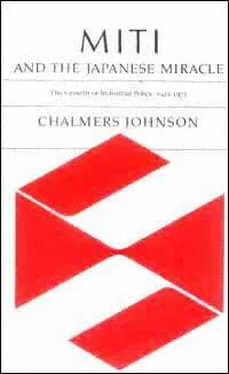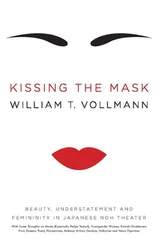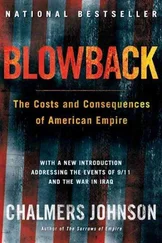Chalmers Johnson - MITI and the Japanese miracle
Здесь есть возможность читать онлайн «Chalmers Johnson - MITI and the Japanese miracle» весь текст электронной книги совершенно бесплатно (целиком полную версию без сокращений). В некоторых случаях можно слушать аудио, скачать через торрент в формате fb2 и присутствует краткое содержание. Год выпуска: 2007, Издательство: Stanford University Press, Жанр: Старинная литература, на английском языке. Описание произведения, (предисловие) а так же отзывы посетителей доступны на портале библиотеки ЛибКат.
- Название:MITI and the Japanese miracle
- Автор:
- Издательство:Stanford University Press
- Жанр:
- Год:2007
- ISBN:нет данных
- Рейтинг книги:3 / 5. Голосов: 1
-
Избранное:Добавить в избранное
- Отзывы:
-
Ваша оценка:
- 60
- 1
- 2
- 3
- 4
- 5
MITI and the Japanese miracle: краткое содержание, описание и аннотация
Предлагаем к чтению аннотацию, описание, краткое содержание или предисловие (зависит от того, что написал сам автор книги «MITI and the Japanese miracle»). Если вы не нашли необходимую информацию о книге — напишите в комментариях, мы постараемся отыскать её.
MITI and the Japanese miracle — читать онлайн бесплатно полную книгу (весь текст) целиком
Ниже представлен текст книги, разбитый по страницам. Система сохранения места последней прочитанной страницы, позволяет с удобством читать онлайн бесплатно книгу «MITI and the Japanese miracle», без необходимости каждый раз заново искать на чём Вы остановились. Поставьте закладку, и сможете в любой момент перейти на страницу, на которой закончили чтение.
Интервал:
Закладка:
kaishime
) and holding goods off the market in anticipation of price rises (
urioshimi
). The result, however, was a chilling of all markets as producers held back goods until the uncertainty was over. Whether Mitsui Trading Company and Suzuki Trading Company were actually engaged in cornering the market, or whether they were importing rice from the colonies and evading the duties on it in order to sell it at the higher domestic prices, or whether Mitsui was primarily intent on driving Suzuki out of business are all relevant issues, but they need not be
Page 92
settled here.
18
The public's fears and suspicions were enough to cause the ''rice riots." (The events of 1918 are similar to the panic of 197374 during the first "oil shock," when the economic bureaucracy again had to intervene to stop speculation in kerosene, toilet paper, soap powder, and other products.) Rice prices soared during 1918, and in July fishermen's wives in Toyama rioted over shortages. The panic spread to consumers elsewhere, and riots occurred through September in some five hundred different localities. The Terauchi cabinet was forced to resign in disgrace.
The new Hara cabinet, representing the Seiyukai* party, had to deal promptly with the matter. Hara made Yamamoto Tatsuo minister of agriculture and commerce for the second time, and Yamamoto pushed the Rice Law of 1920 through the Diet. It removed duties on imported rice and initiated a program for developing rice cultivation in the Japanese colonies of Taiwan and Korea. The law also established a system of price controls over rice that has persisted in one form or another to the present day. Yamamoto's policy thus secured food supplies at reasonable prices for Japan's growing industrial labor force, but in combination with the postwar recession of the entire economy that began in the spring of 1920, it also worsened the agricultural depression and tenant unrest that wracked Japan throughout the 1920's.
19
These developments were a severe economic and political setback for the Teikoku Nokai*, the landlords' association, and it reacted in anger. What the association had previously requested it now demandeda separate Ministry of Agriculture uncontaminated by commercial and industrial concerns and devoted exclusively to agricultural interests. The Hara government rejected these demands, but in 1923 the earthquake again focused government attention on relief of the cities of Tokyo and Yokohama, and again it seemed to farmers that the efforts undertaken on behalf of the cities were much more forthcoming than anything ever done for them. The following year a series of unusually propitious circumstances allowed the Teikoku Nokai's* petition to succeed.
Hara Kei, the first prime minister of Japan to head the government because he was president of the dominant political party in the lower house of the Diet, had been assassinated on November 4, 1921. His successor as president of the Seiyukai party and as prime minister was Takahashi Korekiyo (18541936), one of the truly outstanding figures of Japan's modern economic and political history and not incidentally the first minister of commerce and industry. Born the illegitimate child of an artist and his 16-year-old maid, Takahashi was
Page 93
adopted by a lower-status samurai of the late Tokugawa Sendai
han
. The feudal han sent him to America in the late 1860's to study English, and in 1873, at the age of 19, he obtained a position in the new Meiji government. In 1886, at the age of 32, he became the first chief of the Patent Bureau in the new Ministry of Agriculture and Commerce, thus obtaining an intimate knowledge of the ministry he came to head in 1924. Three years after becoming a MAC bureau chief, he resigned to enter business, at which he was unusually successful. During the Russo-Japanese War he emerged as one of the key financiers of Japan, and by 1907 he was an appointed peer and a baron. In 1911 he became president of the Bank of Japan, and after that he went into politics.
In 1913 Takahashi became minister of finance in the same cabinet in which Yamamoto Tatsuo served as minister of agriculture and commerce. After the assassination of Hara in 1921, Takahashi briefly became prime minister (192122). However, antiparty forces were attempting to reestablish their supremacy, and they organized a series of nonparty bureaucratic governments. In order to resist this movement, Takahashi took the unusual step of resigning his title (he was a viscount by then) and his legal position as head of his family, thereby again becoming what of course he had been borna commoner. He then stood for election to the House of Representatives in the district of the late Hara Kei in Iwate prefecture. After a difficult campaign he won. He and his colleagues forced the bureaucratic government of Kiyoura to resign, a government was formed based on a coalition of all the political parties, and in June 1924 Takahashi again accepted a ministerial portfolio, that of agriculture and commerce. It was as the last minister of MAC that Takahashi presided over the split. (After this term in office Takahashi went on to serve as minister of finance in four more cabinets, until he also was assassinated on February 26, 1936, in the abortive military coup d'etat.)
20
When Takahashi took up the MAC post in 1924, he was known to favor the commercial side of the ministry. He held positive views about the need for governmental promotion of international trade and protection of Japan's growing industries (such as steel)views that were anathema to the landlords and therefore to their association, the Teikoku Nokai*, which opposed imported food but at the same time wanted no duties on imported fertilizer. Because a coalition government was ruling at the time, and because Takahashi was still president of the Seiyukai* party, it was possible to act on the Teikoku Nokai's* petition for a separate agricultural ministry without the political divisions in the Diet that had frustrated action in the past.
Page 94
On March 31, 1925, with Takahashi's backing, the government issued Imperial Ordinance Number 25 establishing a Ministry of Agriculture and Forestry and a Ministry of Commerce and Industry.
During late 1924, while the preparations for this event were taking place, Nakai Reisaku, class of 1903 and former chief of the Forestry Bureau, became vice-minister of MAC. Shijo * Takafusa, class of 1904 and Takahashi's main internal ally, remained as chief of the Industrial Affairs Bureau.
*
Takahashi would have preferred Shijo as vice-minister, but he had no control over internal bureaucratic developments. Then an unusual opportunity developed.
Yoshino was out of the country during the spring and summer of 1924, when the party coalition government came to power. He had been sent to America and Europe to investigate the chemical industry and protective tariff policies. Yoshino was then chief of the Industrial Policy Section in the Industrial Affairs Bureau, having been appointed to that post at the youngest age in the history of MAC by his bureau chief, Shijo. Upon Yoshino's return, Shijo told him that the ministry was to be split. He also told him that Vice-Minister Nakai intended to appoint Yoshino chief of the Silk Section in the Agricultural Affairs Bureau but that Yoshino should turn down the job in order not to be trapped in agricultural administration when the division of personnel between the two new ministries took place.
In December 1924, however, Nakai was suddenly obliged to give up the vice-ministership in order to deal personally with a corruption scandal at the Yawata steel works.
**
Shijo, next in line in seniority to


Интервал:
Закладка:
Похожие книги на «MITI and the Japanese miracle»
Представляем Вашему вниманию похожие книги на «MITI and the Japanese miracle» списком для выбора. Мы отобрали схожую по названию и смыслу литературу в надежде предоставить читателям больше вариантов отыскать новые, интересные, ещё непрочитанные произведения.
Обсуждение, отзывы о книге «MITI and the Japanese miracle» и просто собственные мнения читателей. Оставьте ваши комментарии, напишите, что Вы думаете о произведении, его смысле или главных героях. Укажите что конкретно понравилось, а что нет, и почему Вы так считаете.












